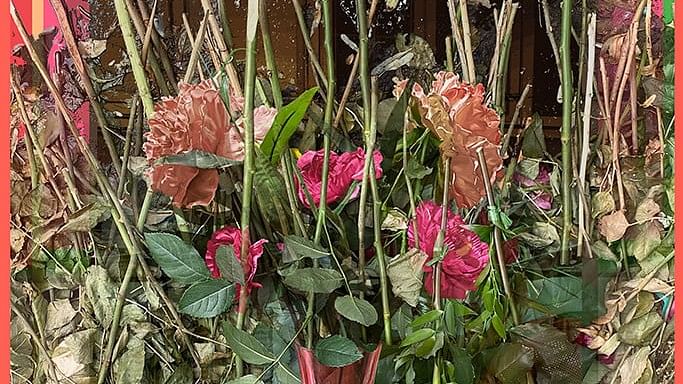
Credit: By Special Arrangement
Berkeley-based multimedia artist Al-An deSouza’s works speak powerfully of memory, nostalgia and history. The exhibition, which was spread across three levels of a gallery in Delhi, brought together their two most recent bodies of work, Flotsam (2021) and A Condensation of Blood (2023), along with an earlier series The Lost Pictures (2004).
The display began with The Lost Pictures, an older series that deSouza created in memory of their mother after she died in 2003. The most personal of deSouza’s work, it consists of family pictures that their father took in Kenya in 1962-63 when deSouza and their three siblings were children. As the dust and debris of everyday life obscured the pictures over time, deSouza treated them with etchings, giving them a unique vintage feeling. “I experienced time not as a linear sequence but as fragmented, a compression of lost pasts and disputed presents, in attempts to invent possible futures,” wrote deSouza in the book that accompanied the exhibition.
Flotsam is somewhat of a continuation of The Lost Pictures, a tribute as it is to their father who passed away in 2018. While it does not have photographs, it consists mostly of deSouza’s “renderings,” or digital paintings based on photographic originals with parts blurred or erased. Based on photographs that they took of their father’s apartment after his death, the poignant images are of his possessions that remained — including plastic bags, medicines, books, restaurant menus, cassette tapes, toothpaste, boxes of chocolate, stuffed toys and rows of shirts hanging in a cupboard. Among the materials in Flotsam, there are also black-and-white family photographs, mostly images of deSouza’s parents in their younger years, which the artist chose not to paint or alter in any way. “My photographs have always addressed the issue of temporality, and have resisted the idea of a photograph being a single fixed moment,” explained deSouza, whose works have been exhibited globally.
A burst of bright colours, A Condensation of Blood, their latest series, has deSouza sharing digital prints of plastic flowers that their mother had arranged in vases at their father’s apartment before her death. Left untouched ever since her death more than two decades ago, these prints are overlaid with images of a photograph that deSouza took in 2023 of a street memorial in Sweden in memory of an innocent bystander who was killed during a shooting incident. Here, the transience of life is ironically portrayed in contrast with the resilience of plastic. “Though I have begun from remnants, from personal family details and a violent incident of public life, I intend that viewers turn towards interpretations and considerations not depicted,” said deSouza.
Born in Nairobi in 1958 to immigrant parents of Goan descent, deSouza migrated with their family to London when they were seven. They grew up in the UK, where they were even the victim of a racist attack, and were involved with Britain’s Black Arts Movement. Drawing became their solace there, and deSouza began obsessively drawing African animals that they knew. “It was my way of holding on to the past, but perhaps a way that drew me back only into myself,” they reminisced.
As an adult, deSouza moved to New York, and later to Los Angeles. Currently, they live and work in the Bay Area, California, where they are a professor in the Department of Art Practice at the University of California, Berkeley. “As someone who has been on the move so much, I feel at home in several places but don’t feel a particular sense of belonging to any one place,” they quite understandably once said. Needless to say, their rich diasporic trajectory layers their works across time and media, threading together several personal, political and cultural narratives. “My early years were filled with the sounds of English, Swahili, Konkani, Kikuyu, and Hindi, with no doubt a smattering of other tongues that I had no names for,” they write.
Further, deSouza is also a writer who has authored numerous articles. In How Art Can Be Thought, they examine how art is discussed, valued and taught within a politicised global culture. In their novel, Ark of Martyrs, the artist pens a fictional rewrite of Joseph Conrad’s 1899 novel Heart of Darkness, blending poetry, rap and prose through a contemporary prism. “Over the last four decades, deSouza has consistently questioned conventional beliefs about photography’s ability to capture and retain singular moments in time, and a photograph’s outwardly inert character,” added Deepak Talwar, Director and Founder, Talwar Gallery.